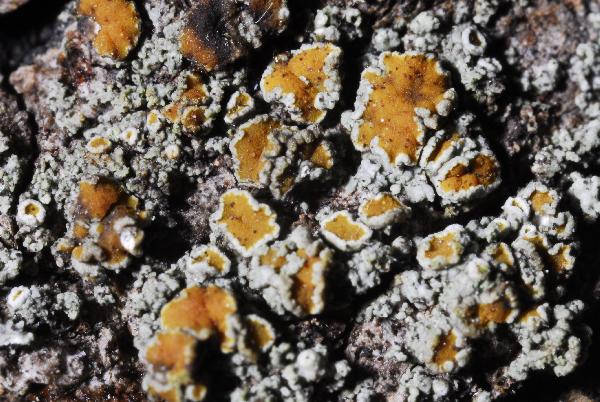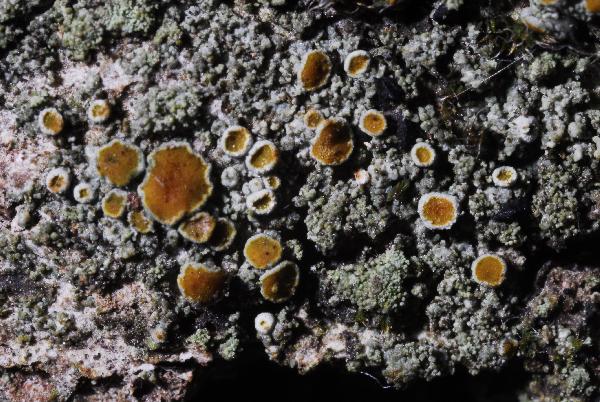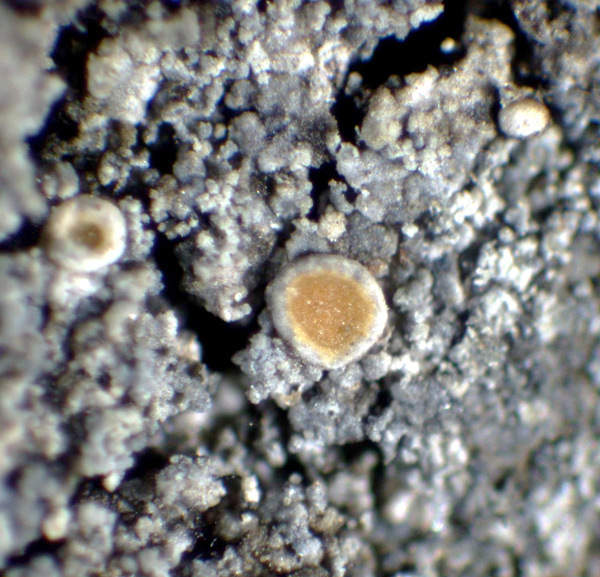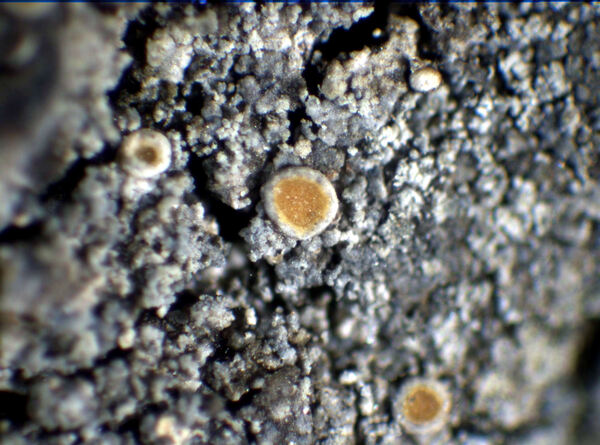Caloplaca turkuensis (Vain.) Zahlbr.
Cat. Lich. Univ., 8: 589, 1932. Basionym: Placodium turkuense Vain. - Ann. bot. Soc. Zool.-Bot. fenn. Vanamo, 6: 320, 1929.
Synonyms: Caloplaca virescens (Sm.) Coppins; Lepraria virescens Sm.
Description: Thallus crustose, episubstratic, areolate, sorediate, up to several cm wide, up to 0.13(-0.3) mm thick, sordid white to pale grey, the areoles small, at first convex but later flat, up to 0.2 mm wide, usually very soon entirely sorediate. Soralia pale to dark grey or greenish grey with a bluish tinge, whitish or greenish inside, scattered to confluent, slightly convex; soredia 15-30 µm in diam. Cortex up to 10(-20) µm thick, paraplectenchymatous; medulla poorly developed. Apothecia lecanorine, abundant to absent, up to 0.8 mm across, sessile, with a flat to slightly convex, yellow-orange, usually epruinose disc, and a grey, often sorediate thalline margin. Thalline exciple 50-85 µm thick; proper exciple poorly evident, up to 15 µm thick, prosoplectenchymatous; epithecium orange, with granules, K+ purple-red; hymenium colourless, 55-100 µm high; paraphyses simple to branched, c. 2 µm thick at mid-level, the apical cells 3-5 µm wide; hypothecium colourless, sometimes inspersed with oil droplets, 55-110 µm high. Asci 8-spored, clavate, functionally unitunicate, apically thickened with a broad internal beak, the inner part of apex and external cap I+ blue, Teloschistes-type. Ascospores 2-celled, polarilocular, hyaline, ellipsoid, 10-15 x 6-9 µm, the equatorial thickening (“septum”) 4-6 µm. Pycnidia sometimes present, immersed, with an elevated, darker ostiole. Conidia bacilliform, 3-4 x c. 1 µm. Photobiont chlorococcoid. Spot tests: thallus K- or K+ violet (reaction best observed on thick sections under the microscope), C- or C+ violet, KC-, P-; disc of apothecia K+ purple-red. Chemistry: thallus with the Sedifolia-grey pigment; disc of apothecia with parietin (major), fallacinal, emodin, teloschistin and parietinic acid (minor).
Growth form: Crustose
Substrata: bark
Photobiont: green algae other than Trentepohlia
Reproductive strategy: mainly asexual, by soredia, or soredia-like structures (e.g. blastidia)
Most common in areas with a humid-warm climate (e.g. most of Tyrrenian Italy)
Commonnes-rarity: (info)
Alpine belt: absent
Subalpine belt: absent
Montane belt: absent
Dry submediterranean belt: very rare
Humid submediterranean belt: rare
Padanian area: absent
pH of the substrata:
1 2 3 4 5
Solar irradiation:
1 2 3 4 5
Aridity:
1 2 3 4 5
Eutrophication:
1 2 3 4 5
Poleotolerance:
0 1 2 3
Altitudinal distribution:
1 2 3 4 5 6
Rarity
absent
extremely rare
very rare
rare
rather rare
rather common
common
very common
extremely common
Loading data...
Occurrence data
Predictive map

Domenico Puntillo - CC BY-SA 4.0
Italy, Calabria, Loc. Lacone (Rende, Cosenza) m. 172 coord. 39°22'40'' - 16°13'40'' leg. D. Puntillo 08-10-2024 su scorza di Quercus pubescens, alla base dell'albero.
Growth form: Crustose
Substrata: bark
Photobiont: green algae other than Trentepohlia
Reproductive strategy: mainly asexual, by soredia, or soredia-like structures (e.g. blastidia)
Most common in areas with a humid-warm climate (e.g. most of Tyrrenian Italy)
Commonnes-rarity: (info)
Alpine belt: absent
Subalpine belt: absent
Montane belt: absent
Dry submediterranean belt: very rare
Humid submediterranean belt: rare
Padanian area: absent
pH of the substrata:
| 1 | 2 | 3 | 4 | 5 |
Solar irradiation:
| 1 | 2 | 3 | 4 | 5 |
Aridity:
| 1 | 2 | 3 | 4 | 5 |
Eutrophication:
| 1 | 2 | 3 | 4 | 5 |
Poleotolerance:
| 0 | 1 | 2 | 3 |
Altitudinal distribution:
| 1 | 2 | 3 | 4 | 5 | 6 |
Rarity
absent
extremely rare
very rare
rare
rather rare
rather common
common
very common
extremely common
Loading data...
Occurrence data
Predictive map










